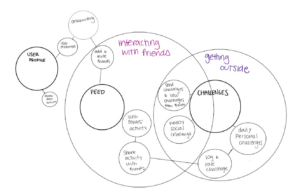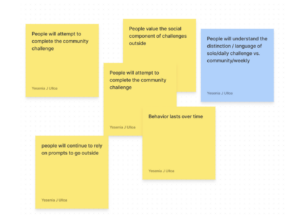In order to help organizing and flesh out key needs for our MVP of our social challenge prompter to get people to spend time outside, we’ve oriented key features, users needs, and design assumption on various planes.
System Path
We mapped out key interpersonal UX interaction by connecting two different personas, city girl Steph with Psetter Kevin with their main needs of activity challenges and social interaction, moderated by the promptmaster and integrating them inside their larger social community.

Bubble Map
 Then, we created a bubble map that fleshes out and breaks down the key components necessary in order to connect our personas with each other, their prompts, and their community at large. The main themes of our solution involve personalizing intentional activities outside and encouraging users to interact with others socially. Therefore, there are 3 main portions of our solution: onboarding and setting up the user profile (personalization), our challenge dashboard (getting outside), and community feed (interacting with friends).
Then, we created a bubble map that fleshes out and breaks down the key components necessary in order to connect our personas with each other, their prompts, and their community at large. The main themes of our solution involve personalizing intentional activities outside and encouraging users to interact with others socially. Therefore, there are 3 main portions of our solution: onboarding and setting up the user profile (personalization), our challenge dashboard (getting outside), and community feed (interacting with friends).
Assumption Map


Finally, after blueprinting our solution with a system path and bubble map, we performed an assumption map synthesis, where we mapped out what we had already figured out and knew and what we still needed to evaluate about what our users actually need and want on a plane comparing known vs. unknown and important vs. unimportant assumptions. From this assumption map, we selected the important and unknown assumptions that are still critical to evaluate for this stage of our prototyping.
Assumption Test
The three main important and unknown assumptions we wanted to test were:
Assumption 1: People value the social component of challenges outside.
We want to determine if people will actually attempt to complete community challenges as a proxy for their attitudes towards the social component of spending time outside.
Experiment 1:
- Collect participants
- Survey participants on their availability/ prompt preferences
- Suggest a challenge to people who have the same availability and preferences in a group chat
- Follow up and see if they actually did the challenge
Assumption 2: The challenges are motivating for the users.
We want to answer if challenges + notifications will be effective for users to change their behavior over a sustained period of time and if users find notifications useful or if we should explore some other form of nudging.
Experiment 2:
- Collect participants
- Survey participants on their availability/ prompt preferences
- Challenge participant over a time period (week) with a prompt that is tailored to them
- Review challenges completed by participants
Assumption 3: People will understand the distinction between the language of solo/daily challenge vs. community/weekly.
Experiment 3:
- Collect participants
- Survey participants on their availability/ prompt preferences
- Combine experiments 1 and 2 at the same time.
- Ask users to perform a post study survey including questions to assess their understanding or confusion of the architecture of the solo challenges occurring daily and social challenges occurring weekly framework.




Comments
Comments are closed.